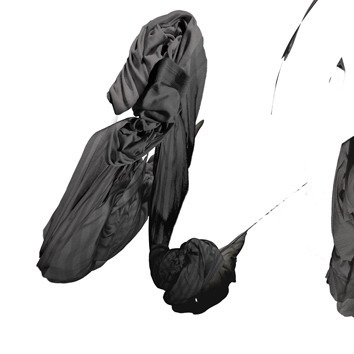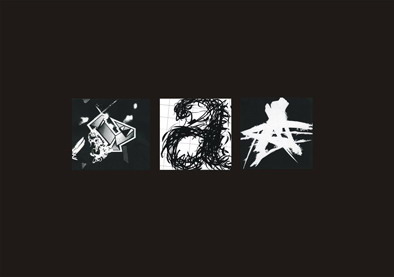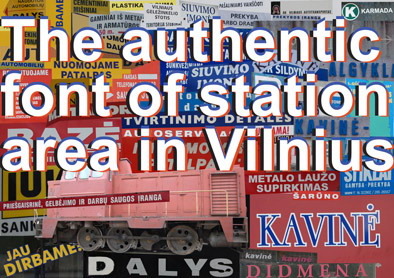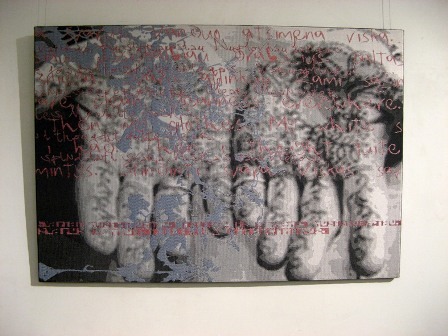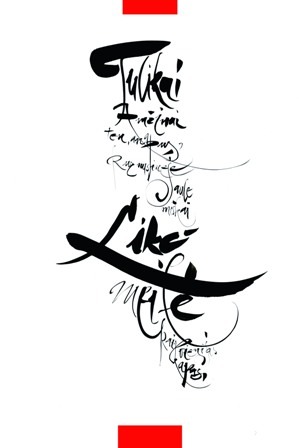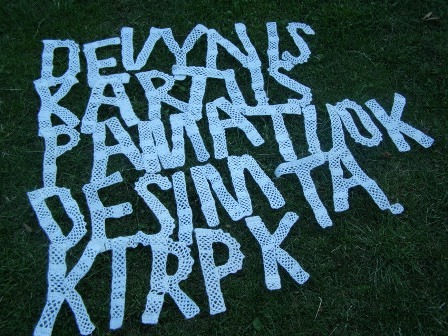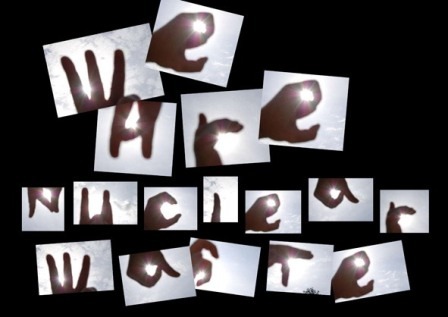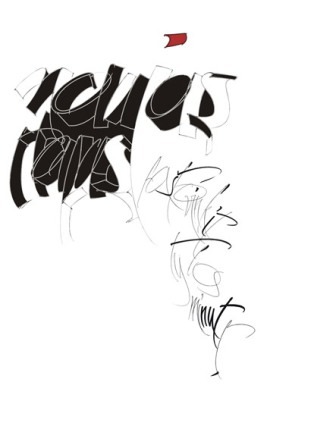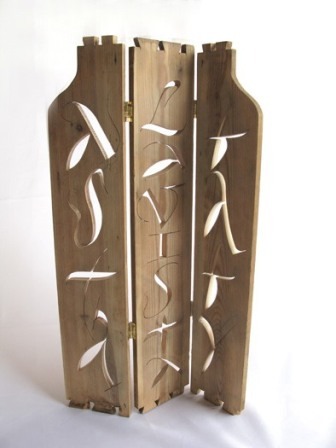ART OF LETTER: AMID EXTINCTION, INTERPRETATIONS AND ILLITERACY 0
(Review of classical and contemporary letter and script art in the face of the exhibition “Travelling Letters” organised in Saint Petersburg and computer illiteracy) Dr.Rasa Andriušytė-Žukienė
www.kamane.lt, 2008 10 05
Eglė Bogdanienė. Don't Believe in Beauty. 2006. Weaving by computer machine, cotton, paper, 100 x 30 cm
Giedrė Karsokienė. Wrinkles. 2008. Photo-graphics, digital printing. 40 x 40 cm
Algis Klisevičius. Travelling Letters. 2008. Digital printing, paper. 100 x 70 cm
Audrius Klimas. Centenarian Dust of my Sauna. 2008. Photo-graphics, digital printing on atlas. 60 x 60 (4 parts)..
Marius Bartkus. The Authentic Font of Station Area in Vilnius. 2008. Typographic, digital printing. 85 x 60cm
Jūratė Veteikytė. Insomnia. 2008. Typographic, digital printing, 80 x 80 cm
Greta Grendaitė. Psychoacoustics of Sound "A". 2008. Ink, paper, digital printing, 27 x 50 cm
Eglė Vengalytė. Hands. 2008. Weaving by computer machine. 103 x 71 cm
Rasa Bockutė. For Paulius Širvys. 2008. Digital printing, 60 x 90 cm
Severija Inčirauskaitė-Kriaunevičienė. Measure Nine Times, Cut the Tenth. 2008. Crochet, changing format
Robertas Jucaitis. We are Nuclear Waste. 2008. Photography, digital printing. 100 x 70 cm
Mindaugas Petrulis. White Meadows. 2008. Ink, paper, digital printing, 100 x 45 cm
Mindaugas Petrulis. One-minute of Silence. 2008. Ink, paper, digital printing, 70 x 100 cm
Rimvydas Kepežinskas. Object "Screen". 2008. Wood (drawers), 73 x 44 cm
Andrius Balvočius. M Book. 2008. Digital printing, paper, 70 x70 (4 parts)
In brief: When did you receive a letter with a carefully inscribed address on the envelope the last time? Calligraphic greetings, compositions of letters on book covers, in posters and postcards have become rarities. Electronic space seems to have pushed away this phenomenon – manuscript and calligraphy art for good.
Still, neither Lithuanian nor other countries’ artists have forgotten this art yet. Three exhibitions dedicated to script are held in Saint Petersburg at the present time. The International Calligraphy Exhibition is open at I.Repin Art Academy, where one may see calligraphy works of Russian, German, American, Arabian, Australian, Chinese artists.
The exhibition “Petersburg and Books in National Languages” is open at the National Russian Library. The exposition “Travelling Letters” of Lithuanian designers, graphics and textile artists is also open in Saint Petersburg, at the Lithuanian general consulate. It opened the page of graphic design, which is not often seen in exhibitions, and enabled to reflect on the level of letter and script art as well as possibilities in the contemporary real and virtual world.
Two tendencies enjoyed by artists differently became prominent: traditional fine writing called calligraphy is not very popular; however, the conceptualisation of a letter or word as a visual sign is becoming top-line.
The beginners of professional Lithuanian art Mikalojus Konstantinas Čiurlionis, Petras Rimša, Paulius Galaunė created wonderful initial letters used in the press at the beginning of the 20th century. Traditions are continued at Vilnius, Kaunas, Klaipėda higher art schools, where lectures on calligraphy are read. One of the most important cherishers of script art A.Gurskas states that calligraphy is a means of emotional expression of a personality.
Beauty and elegance, decoration is more important than content in a calligraphic text. In general, painting, drawing and calligraphy is related by many things: importance of concentration, expression of line and colour, masterful work by a brush. There are not many creators of real traditional calligraphy in Lithuania (Algis Kliševičius, A.Gurskas, A.Lisauskienė, Mindaugas Petrulis, Rasa Bočkutė), as artists stopped training their hands and use more modern means.
On another hand, visual culture that has become popular creates preconditions to accept letters as signs, plastic figures or to take ideas from them for experiments (Algis Kliševičius, Andrius Balvočius, Greta Grendaitė).
Letters and text expressed by them become a declaration of unexpected or conceptual attitudes very often today: feminist issues, problem of beauty, global issues of humanity are solved by using the parallels between a letter and a human body form (Inga Pakštaitė).
Conceptual experiences are important while creating from textile materials (Almyra Bartkevičiūtė, Zita Inčirauskienė, Severija Inčirauskaitė-Kriaunevičienė), while forming letters from photographed human body parts (Robertas Jucaitis) or when giving importance to materials and inscriptions (Eglė Bogdanienė, Giedrė Karsokienė, Jūratė Veteikytė, Kęstutis Vasiliūnas).
Differently from traditional calligraphy, conceptualists of letters art, who usually use computer programmes, digital cameras in the creation process, try to preserve the initial function of a letter and script as the carrier of information. Computerisation makes some positive influence on this field of art. Unexpected and creative interpretations emerge, which replenish the contemporary art fund full of ideas, solutions and misunderstandings.
The exposition of thirty Lithuanian artists in two halls of the Lithuanian general consulate replenished the international calligraphy exhibition open at I.Repin Art Academy in Saint Petersburg in a topical way. Meanwhile, in the latter international exhibition, one could find works of classical calligraphy. However, the bombastically presented exhibition lacked original solutions and intrigue of artistic searches.
Ending the review, the author comes back to the Lithuanian computer fonts. We have the only Lithuanian computer font Palemonas created by the Lithuanian language specialists and artist A.Gurskas by now. It is used by the Lithuanian language specialists researching dialects and writing dictionaries the most frequently. Palemonas is not very pleasant on the screen and is not very popular due to this reason perhaps. Thus, the author questions whether we should not take a thought about this fact while sending numerous lisping e-mails to each other.









